|
127 rollfilm was smaller than 120 rollfilm used for medium-format cameras but slightly larger than 135 film. Because it was a rollfilm, without the need for a rewind knob or a wind-lock mechanism, the cameras could be kept compact. Particularly the half-format cameras, which made 4x3 cm exposures, were therefore usually smaller than equivalent 135 film cameras, even though it produced larger negatives than the 135 film 35x24 mm format.
The backing paper of 127 rollfilm only had markings for 8 (6x4 cm) or 12 (4x4 cm) exposures - cameras for 4x3 cm half-format negatives had therefore two windows at the back that needed to be used alternately. Unfortunately 127 rollfilm is no longer easily available.
Nagel Pupille & Ranca
Nagel was a camera manufacturer founded by August Nagel, one of the great names in camera history as the designer of the Kodak Retina series. Only few Nagel cameras exist, amongst which the Vollenda, a folding camera that came in various sizes, and the Pupille, as small 127 3x4 camera. It was sold as Rolloroy in the U.K. and a simpler version was called the Ranca.
The 1932-1935 Nagel Pupille was a very small camera with a telescoping lens base on a helicoid and a shutter/lens assembly with its own focussing helicoid. It was available with several lenses, including a Leitz Elmar, which is rather unusual as Leitz did not produce many lenses for other camera makers, and Schneider Xenon or Xenar. To load the Pupille with film the whole top plate with attached film transport mechanism had to be removed from the camera. A set of rollers would guide the film, ensuring smooth film transport.
The camera stayed in production after Nagel was taken over by Kodak, it can therefore also be found with Kodak marked on the shutter plate.
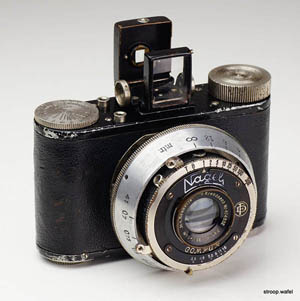
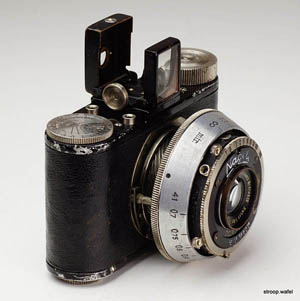
Nagel Pupille with Xenar 50mm f/3.5 lens in Compur shutter. Early Schneider lenses like this one were marked with "Jos. Schneider & Co.". Based on the Compur shutter serial# this example was built in 1933. It has a metal focus ring, whereas most Pupilles had a black one. This one is unfortunately also missing the lever to rotate the lens base helicoid.
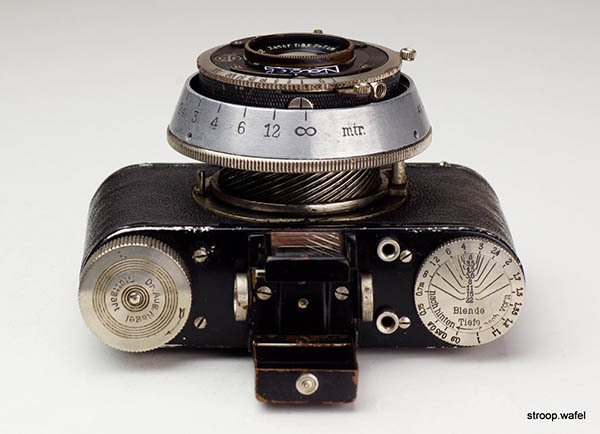
Top view of Nagel Pupille. The depth of focus scale is similar to the one found on folding Retinas. The two little holes were for mounting an accessory rangefinder, like the ones found on early Leicas.
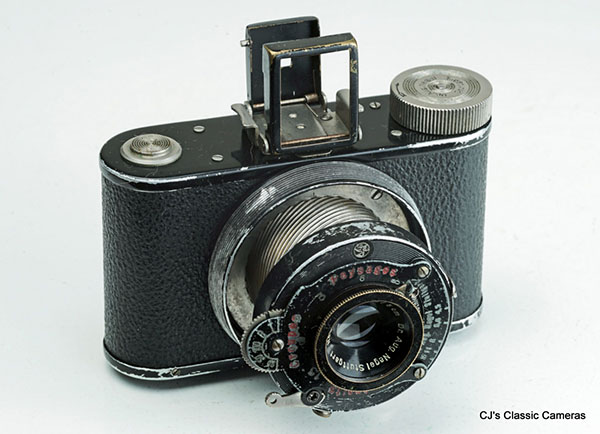
A simpler version of the Nagel Pupille was the Nagel Ranca. Instead of a helical focus mount it had a helical lens tube which needed to be fully extended prior to making a photo, and the lens was focussed by turning the lens front element. The Ranca also had a simpler self-cocking Pronto or Vario shutter, lacked a depth of focus scale dial, and had a slower f/4.5 aperture. Some versions had a collar around the lens tube, which therefore could no longer be retracted. I am pretty sure the Ranca was introduced around 1930 or 1931, so about a year before the Pupille.
Nagel Vollenda 48
The Nagel Vollendas were a range of folding cameras available in various formats, from 3x4 (127 film) up to 6.5x11 (116 film) format. The ones here are the 127 film version, just like the Nagel Pupille described above. In fact, the cameras had quite similar designs, except of course the way the lens and shutter were mounted to the camera body. The Vollenda 48, as this format was designated, had a front door that swung downwards, which is rather unusual for this camera format and more often seen on larger 6x6 cameras. They were well built and came with all the popular shutter-lens combinations available at the time, including Radionar, Xenar and Tessar lenses, and even Leitz Elmars.
Like the Nagel Pupille above, the Vollenda stayed in production after Nagel was taken over by Kodak; it can therefore also be found with Kodak marked on the shutter plate. However, both the Pupille and the Vollenda were phased out when the Kodak Retina was introduced, marking a shift from rollfilm to 35mm film.
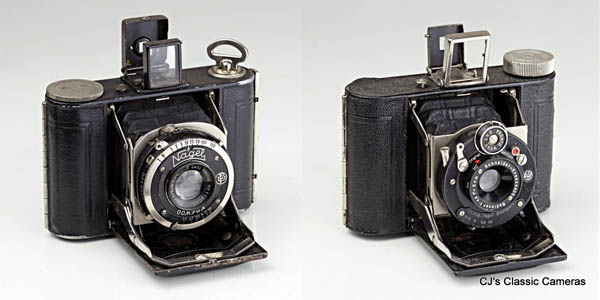
Two different Nagel Vollenda variants, one (right) with Schneider Radionar 50mm f/3.5 lens in dialset Pronto shutter from 1932, the other (left) with Leitz Elmar 50mm f/3.5 in rimset Compur shutter from 1934. Note several small differences between the variants, including the wind knob/key, the presence of a depth of field scale and the style of viewfinder.
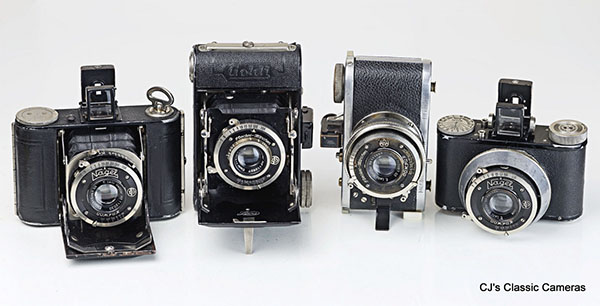
In the early 1930s a select few non-Leica cameras were available with Leitz Elmar lenses. Over the years I've acquired four of them, which are shown above, a Nagel Vollenda, a Zeh Goldi, a Mentor Dreivier and a Nagel Pupille. These are all 127 rollfilm cameras, but it's worth noting that the Welta Welti and Weltini were also available with Elmar lenses, and these were 35mm cameras. These Elmars were all 50mm f3.5 lenses, but I have seen Elmars with other formats as well, including a 105m f/4.5 Elmar on a Nagel Recomar plate camera.
I've found very little information about these non-Leica mounted Elmars. Most fall in a narrow range of serial#, starting probably at 100,000 up to at least 113,000, although I have seen serial# as high as 195,500. These numbers appear to be correct for the age of the cameras, which suggests that some of the production on lists with Leitz serial numbers went to other camera manufacturers. Most of these Elmars are mounted on cameras with helical focus mounts, but the Zeca Goldi above has a front-cell focussing Elmar. The ones in my posession all look very similar, but some small differences are present when looking carefully, most notably a change in engraving from Elmar 1:3,5 F=5cm to Elmar f=5cm 1:3,5.
As to optics, they have 4 elements in 3 groups with a cemented rear group, just like the regular Elmar found on Leicas. However, they have the aperture behind the middle cell, whereas for the regular Elmar it is located behind the front cell. The lens reflections and distance to the film frame are the same or at least very similar though, suggesting these Elmars are optically very close if not identical to the ones found on Leicas.
Mentor Dreivier
Mentor was a small camera maker in Germany active in the first part of the last century that mainly focussed on large format cameras. One of the exceptions was the Mentorett, a rare focal plane TLR camera, another was the Dreivier, which is shown here, sold from 1932 until about 1934. It was a small camera with collapsible lens for 3x4 format on 127 roll film. There are quite a few similar cameras on this page, but the Dreivier did stand out by being relatively large but also by having an excellent build quality. It had a helical focus mount, a viewfinder with parallax correction and a nice latch mechanism for removing the camera back. The whole camera oozes quality. Except, perhaps, for the nickel plating, often worn from the wind knob, and the black enamel paint, which is frequently chipped off. It is most commonly found with a f/2.8 Tessar lens, but a f/3.5 Leitz Elmar version was also available (see photo).
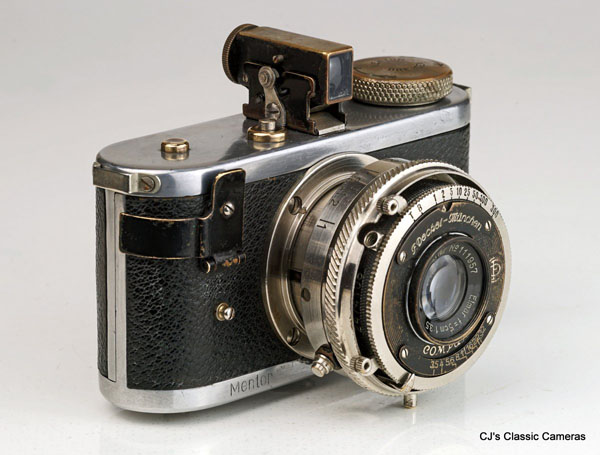
A lovely Mentor Dreivier with Leitz Elmar 50 mm f/3.5 lens in Compur shutter. This looks like a chrome version, but I suspect it was original covered in black enamel, as a few small black chips are left on the bottom plate and some of the bare metal parts show faint grinding marks. I have seen a few similar ones on the internet, but also ones that have some black parts left, including the viewfinder, which clearly was painted originally. So in all likelihood, all metal Dreiviers were black originally.
The is no reason to doubt the Leitz Elmar lens is original. These are rare lenses on non-Leicas, but can be found on several contemporary camera models, such as the Nagel Pupille and Vollenda, the Welta Welti and the Zeca Goldi. Note that even though the Dreivier is rare, there were still several slightly different versions. This example has strap lugs as well as a foldable stand (the back part on the front left), so is a late production one. A slight oversight from Mentor is that the camera doesn't quite stand straight up when the stand is used because of the addition of the strap lugs.
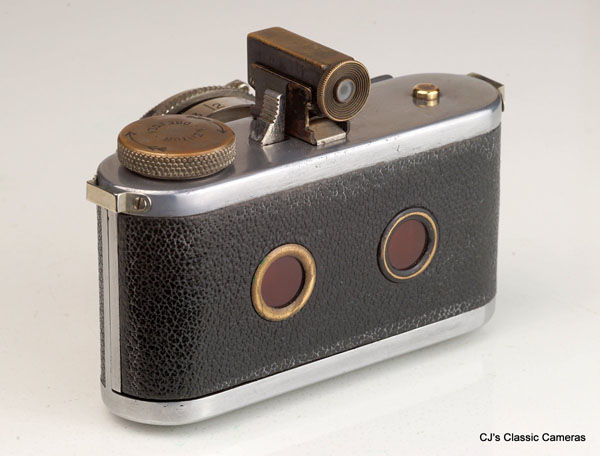
| |
Rear view of the Mentor Dreivier showing two red windows, typical of 3x4 format cameras for 127 film. Also note the metal part next to the viewfinder, which is the latch to open the camera body, the camera top and back come off when this latch is pushed.
|
Kuwata Mulber
The Mulber is a very rare camera. In fact, the first time I saw it is when I saw it for sale on a certain auction site, and when I tried to find information on it, the camera-wiki site had a segment on it based on adverds but no photos of the real thing. Then it said: 'no examples are known to survive'. I am quite sure some must be around in Japan, but these are often not well documented. In any case, here is a surviving example!
The Mulber reminded me of the Mentor Dreivier just above, which is why I am showing it here. It's not as fancy, it's made of bakelite for a start, but is has a similar body design, a telescopic lens, and viewfinder and wind knob in the same place. It even has a wind knob engraved with its name. It used 127 film and had the same 3x4 film format.
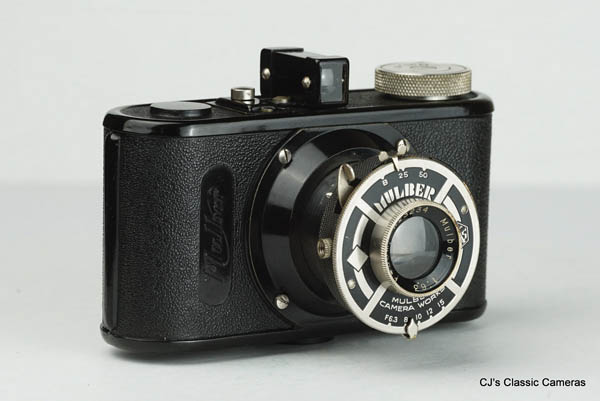
Kuwata Mulber 3x4 with Mulber lens in Mulber shutter. The camera comes apart in two parts to load film by unlocking a little switch at the top of the camera.
The comparison ends there, the Mulber had a very simple two-speed shutter and a rather slow f/6.3 fixed-focus double meniscus lens. Everything is branded Mulber on the camera, the lens, the shutter, the body, the wind knob, although the shutter also has a logo with the letters KKS. Information from camera-wiki suggests that the distributor of the camera was Kuwata, although it's unclear which company actually made it. It was first introduced until 1936 and was made until about 1938 or 1939. The site shows a few photos of advertisements but these are all in Japanese, which is not my strength. Their rarity suggests it never became a sales hit. So enjoy the one shown here, you're unlikely to see one ever again!
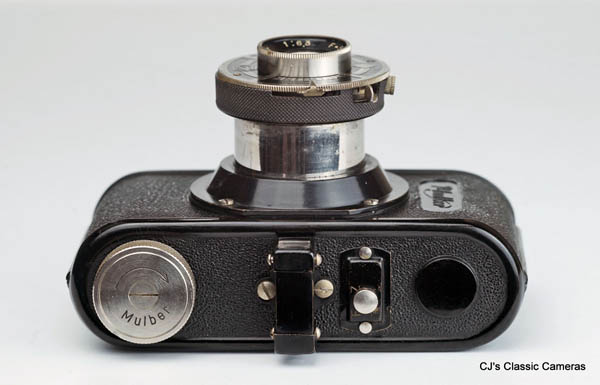
Top view of the Kuwata Mulber with its lens extended.
Ruberg Futuro
The Ruberg Futuro was a eye-catching little camera with screw-out lens and foldable viewfinder. It was made in Germany around 1934 and featured a two-speed shutter. It used 127 film and could take photos in 4x3 or 4x6 format by means of an internal mask. This in itself wasn't particular unusual, but the Futuro allowed you to change the mask with film loaded by means of a switch button on the bottom of the camera. Thus one could get 4x3 and 6x4 format on the same film. It would have taken a little bit of care to avoid overlapping frames when switching from one format to the other, but I wish more cameras had that feature.
Ruberg & Renner (the full name of the company) made several more pocket-sized cameras, often using bakelite components, and several name variants of the Futuro exist, as well as versions with a crackled paint effect. The company's diversion into cameras only lasted a few years, its main business being industrial products and bicycles.
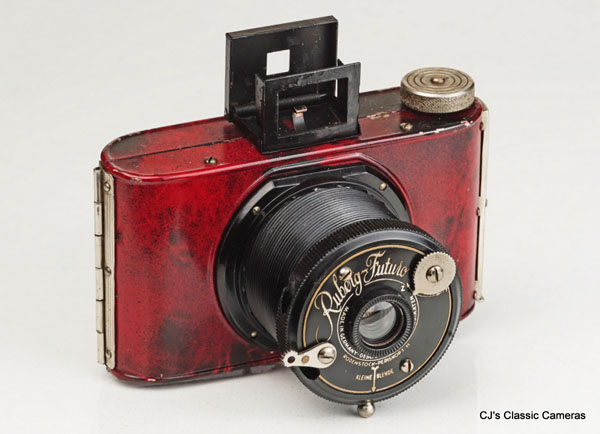
Ruberg Futuro with Rodenstock-Periskop f/11 lens of unspecified focal length, but presumably around 75 mm in line with other 6x4 format 127 film cameras.
Ising Puck
The Ising Puck was an elegantly styled and compact 127 rollfilm camera with a collapsible lens. It had a rather small viewfinder and the shutter had to be cocked and fired on the shutter itself. Like most half-format 127 cameras it made negatives in portrait orientation. It came with a range of shutters (Prontor II, Vario, Compur-Rapid) and lenses (Staeble Kata, Steinheil Cassar, Rodenstock Trinar).
There is very little info about this camera or its manufacturer, lens serial nrs suggest the Puck was likely produced between 1948-50. Other cameras from the same company, which was based in Bergneustadt, Germany, were the 6x6 Ising Isis from 1953-4 and the Pucky, a range of simple pseudo-TLRs, which were also sold in the US by Sears and Bolsey.
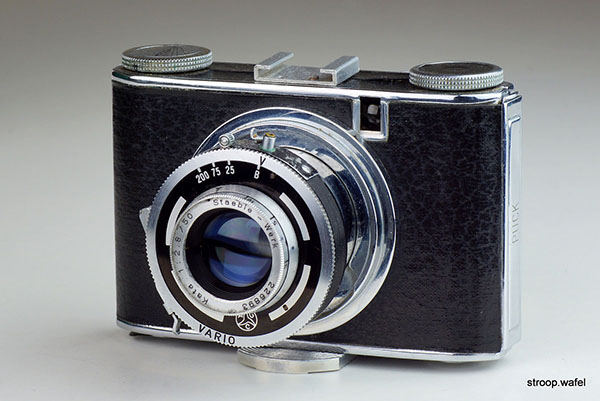
Ising Puck with collapsible lens and convenient fold-up stand.
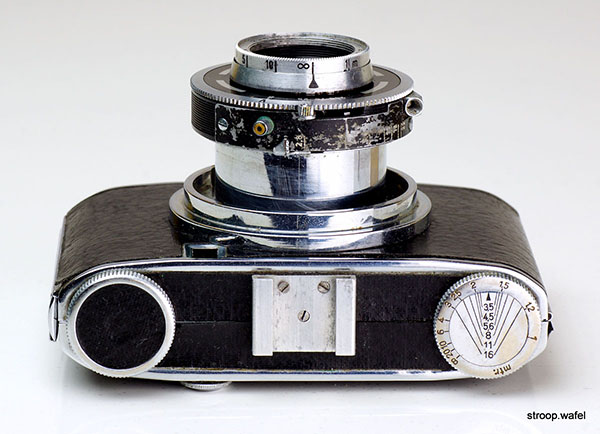
The top of the Puck had a depth of field indicator and wind knob as well as an accessory shoe.
Miyagawa Picny
The Picny was introduced in 1935 by Miyagawa from Japan. It was very similar to the later and more common Gelto (see below), so similar in fact that it is hard to believe the camera was not made by the same company. It is said the Picny was inspired by the Wirgin Gewirette. I'd argue that the Picny was of higher build quality and also benefitted from a helical focus mount with an impressive shortest focus distance of only 1/3 m.
The main difference with the Gelto was that the Picny was a little smaller and had a wider lens (40mm vs. 50mm). Also, it missed an accessory shoe but had a holder for a screw-in lens filter instead. Finally, the shutter had a smaller range of speeds. The film frame was only 36x25mm, a little smaller than the normal 127 roll film frame size of 40x30mm, and in fact pretty much the same as 'normal' 35mm film.
The same Miyagawa company also made the Boltax, which can be considered the bigger brother of the Picny but made for Bolta film, i.e., the film for the early Boltavit and Photavit cameras. A Picny 35 also existed, larger still as meant for 35mm film. All these are rare and hard to find, certainly here in the west.
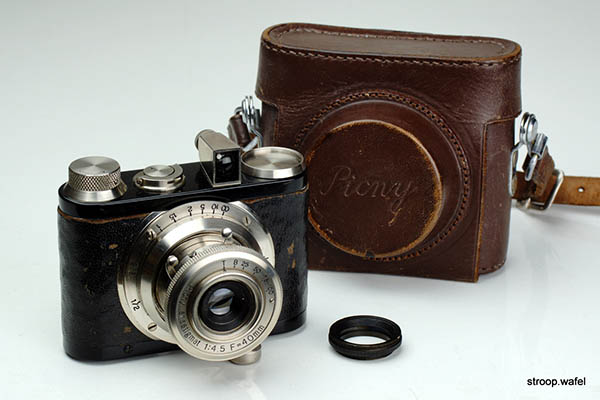
The very cute Picny with a collapsible Picny Anastigmat 40mm f/4.5 lens. The beautiful nickel-plated metal work and black enamal body attests to the high build quality of this 80-year old camera. Only the leather has not survived as well. The small black ring is a filter which could be screwed onto the knob next to the viewfinder when not in use, a nice touch.
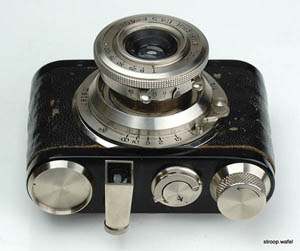
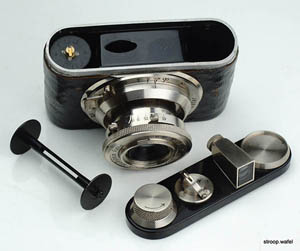
Top view of the Picny (left) and one with its top removed (right) with a 4cm 127 spool for scale.
Boltax III
The Boltax was build by the same company as the Picny above. Technically it shouldn't be in this list, as it did not use 127 film, but Bolta film instead. This was the rollfilm developed for the Boltavit/Photavit camera range, and the Boltax was clearly inspired by the first Boltavit models. However, it was arguably of much better build quality, well outshining its 'parent', just like in fact the Picny above outshone the Wirgin Gewirette upon it was based. The Boltax was essentially a miniature version of the (already small) Picny, it has a similar removable top locked with a latch, and a similar helical focus mechanism with the shutter and lens mounted at the end of the helicoid tube. The Boltax was introduced just before WWII and was built up until about 1942, when Japan joined WWII.
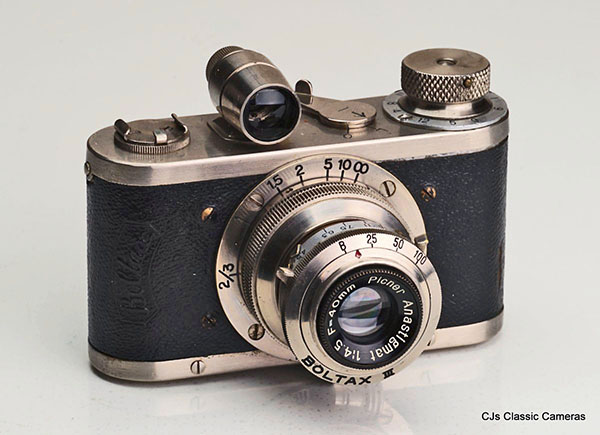
Miyagawa Boltax III with Picner Anastigmat 40mm f/4.5 lens.
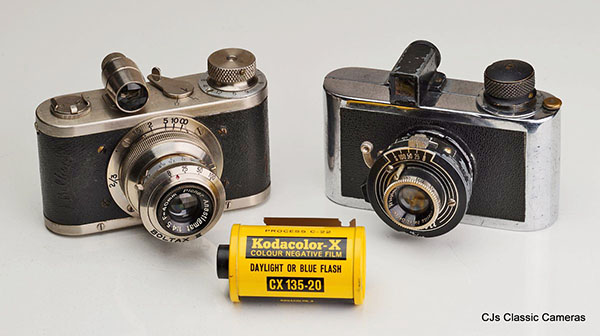
Comparison of the Boltax III with the Boltavit II on which it was based, but which it easily surpassed in features and build quality. Note the 35mm film cartridge is shown for scale only, as both cameras used 'Boltax' film, a 35mm paper-backed rollfilm without perforations.
Toakoki Gelto
The Gelto was a range of well-constructed 127 rollfilm cameras produced in Japan by Toakoki Seisakusho from about 1936 to 1952. Its design was based on the very similar Picny (see above). The Gelto had a collapsible lens with a helical focus mount. On early models the top plate had to be removed to load film, on later models the whole back would come off. The most common model has a D III shutter and was introduced in 1937, it is known as the Gelto-DIII, but this name was never actually used for marketing the camera. It came in a variety of body coverings, including black leather, silver and gold versions.
The same company also made folding cameras, including the Semi Gelto, which is shown elsewhere on this site.
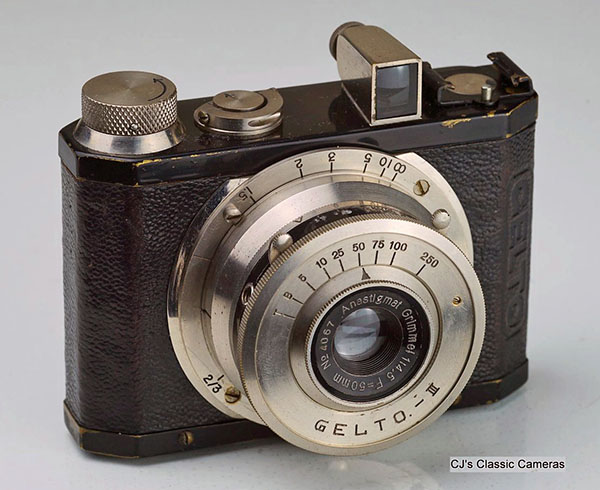
A very early black enamel pre-war version of the Gelto with Grimmel Anastigmat 50mm f/4.5 in Gelto-III shutter and body serial# 864. It is almost identical to the more common version with Gelto-DIII shutter below; the only difference I could find was that on this model aperture numbers are engraved in the shutter housing as opposed to indicated on a screw-on strip. However, I have seen later Gelto-III that also had such a strip, so the mystery what exactly is the difference between the 'III' and 'DIII' remains.
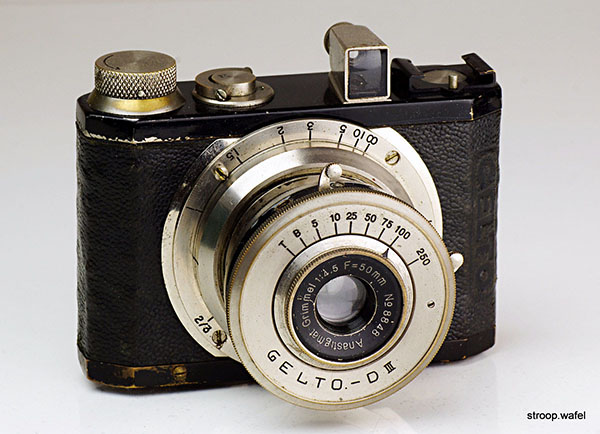
Black enamel pre-war version of the Gelto with Grimmel Anastigmat 50mm f/4.5 in Gelto-DIII shutter. This example had a problem with the helical focus mechanism because of a loose metal guide rail, which are quite fragile. The shutter on most Geltos have also not stood the test of time well, this one works but not the B and T settings.
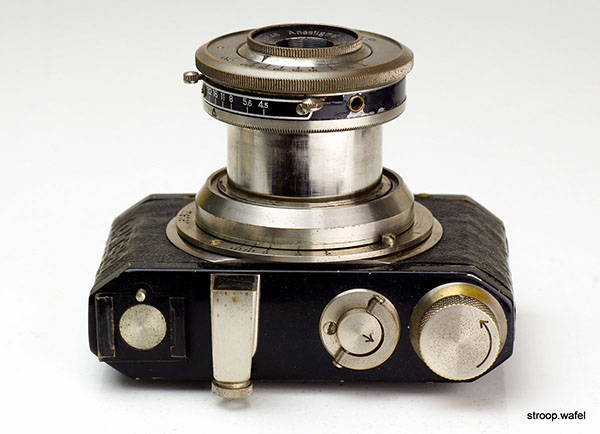
Top view of the pre-war version of the Gelto with collapsible lens fully extended.
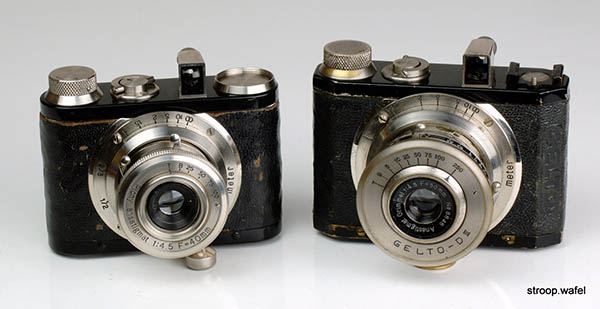
Side by side comparison of the Picny and the Gelto, the former slightly smaller than the latter, but otherwise nearly identical. It is hard to believe these were made by different companies.
The New Gelto 3x4 had a removable back and base plate instead of the removable top plate of the earlier Gelto models. The turning key to open the back was located on the bottom plate. Otherwise the construction was very similar to the earlier model, including the shutter which was still marked Gelto D-III. The metal work was finished with chrome instead of nickel like the earlier model.
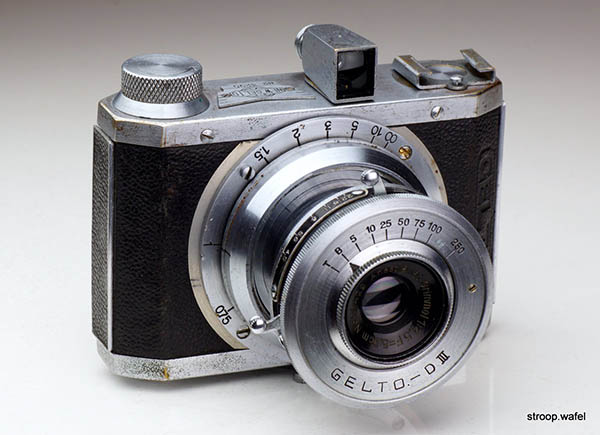
New Gelto with Grimmel Anastigmat 50mm f/4.5, like the one above. Early production had New Gelto engraved in the top plate, later models, like this one, had a name plate.
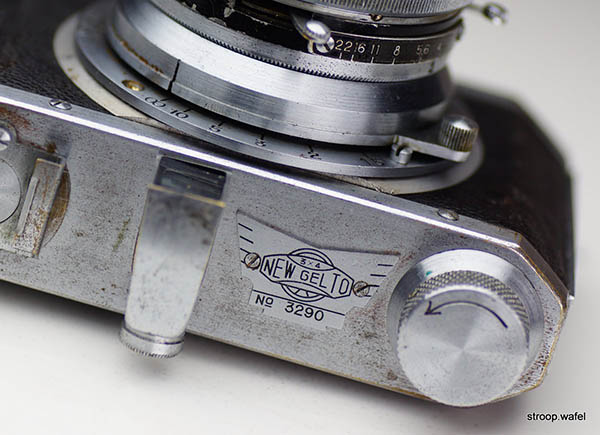
Detail of the New Gelto showing the name plate. Camerapedia suggests this was to cover a hole in the top plate, but that is not true in this case, there is nothing under the name plate.
The next change in Gelto models was the introduction of bodies with a gold or silver metal finish and a back release catch located on the top plate. It appears this was after production of cameras restarted after WWII. Initially, these Gelto came with different shutters, perhaps because the manufacturer of the D III shutters was not yet back in production. It also appears the numbering of the lenses was restarted. Unlike the later Geltos, the early gold models had the name of the company Toakoki Seisakusho engraved on the side (see below).
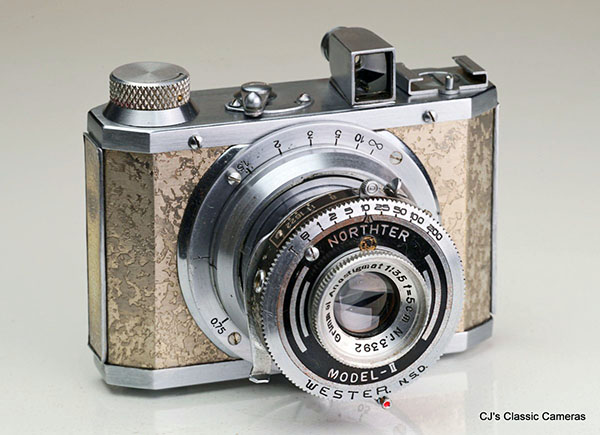
Early post-war Gelto with Northter Model-II shutter and Grimmel Anastigmat 50mm f/3.5 lens. It has an unusual coarse-grained gold-coloured finish. The shutter was made by Nishida, who also made the Wester shutter. Curiously, both these names are marked on the shutter. A strange feature of this camera is that it has only a single red window at the back, despite it having a 3x4 film frame like the other models.
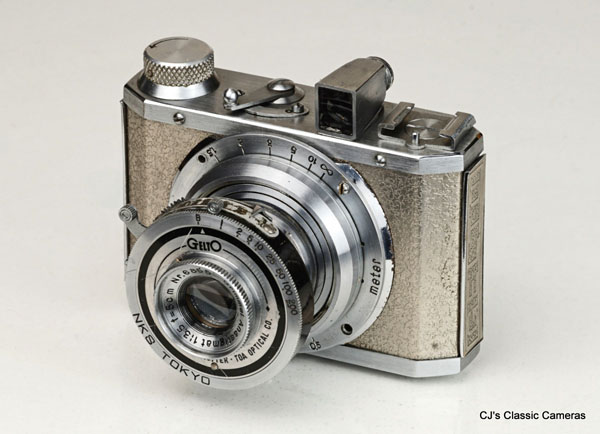
A slightly different post-war Gelto, this time with New Paragon shutter by Toa Optical Co and the standard Grimmel Anastigmat 50mm f/3.5 lens. The shutter ring bears the name NKS Tokyo, which is a little confusing, as that's a different company (Nippon Kosokki) than Toa Optical. The back of the camera says 'Made in occupied Japan', typical of postwar cameras. This camera has the fine-grained gold-coloured pattern typical of most later Geltos.
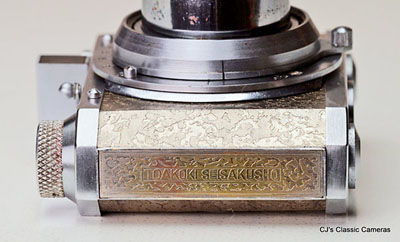
|
The company name Toakoki Seisakusho as engraved on the side of the Gelto with Northter shutter.
|
The later post-war Geltos featured D III shutters again and had coated lenses. Some of these are marked 'Made in Occupied Japan' at the back.
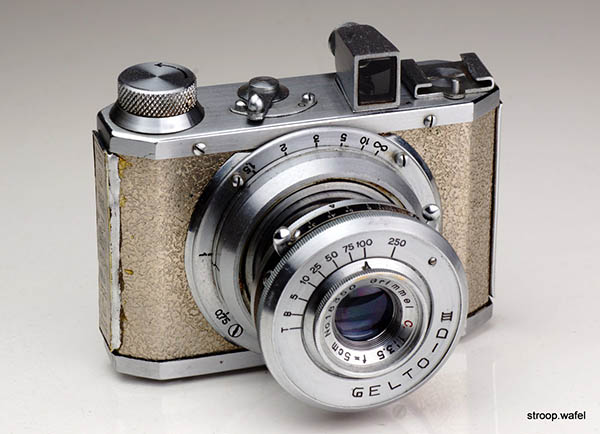
A gold-coloured post-war Gelto with coated Grimmel C 50mm f/3.5 lens and with 'Made in Occupied Japan' markings on the red window cover at the back. This is the most common post-war model.
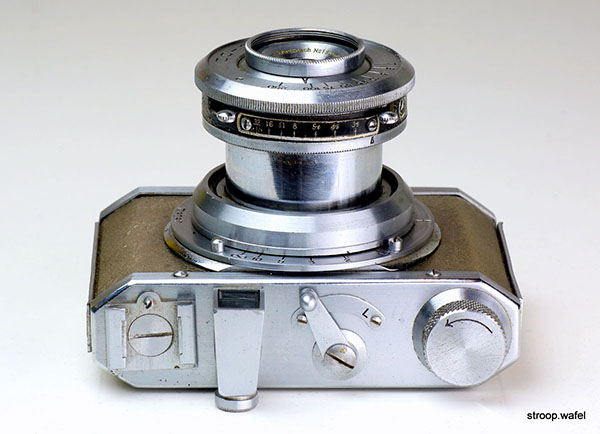
Top view of the post-war Gelto-DIII with collapsible lens extended. Note the lever to release the back, instead of a turning key like the pre-war version above.
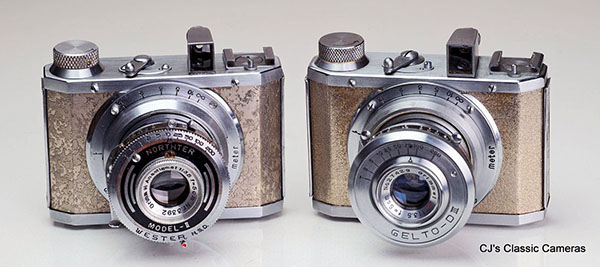
Two versions of gold-coloured Geltos. Note the difference in the patterns of the metal body.
Toakoki Arsen
The Arsen was a special version of the Gelto sold by Ars, which was the publisher of Ars Camera, a Japanese camera magazine. The Arsen had a few different features from the standard Gelto, the most significant of which was the different film frame, with was 4x4 cm instead of 3x4 on the Gelto. It therefore had only a single spy window at the back. In addition it had a wind mechanism with a frame counter and an automatic frame stop in a heightened section of the top housing. Other than that it was nearly identical to the pre-WWII version of the Gelto, including the removable top plate to load film and the collapsible lens with helical focus.
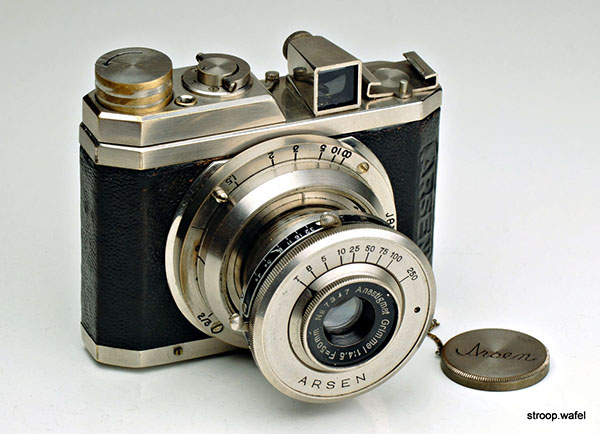
A Toakoki Arsen with Grimmel Anastigmat 50mm f/4.5 in Arsen shutter. Note the chained metal lens cap with the name Arsen engraved, a nice feature not found on the Gelto. The main blemish of this example is the wind knob, which had the grooves filed off by a previous owner, presumably in an ill-conceived attempt to remove the top housing.
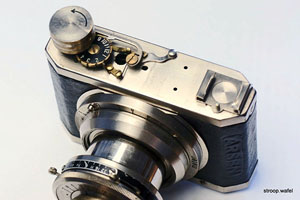
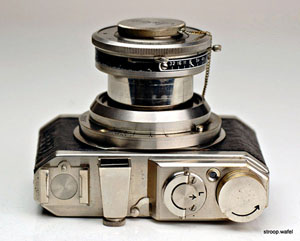
(left) The wind and frame counter mechanism inside the top housing of the Arsen. Pushing the long lever would reset the wind mechanism to 0 once the end of the film was reached. (right) Top view of the Arsen, with the small spy window for the frame counter located just left of the wind knob.
Riken Zessan
The Riken Zessan had a lot of similarities with the Gelto above, but was from a completely different company. Information about this camera is quite sparse, but Riken was the predecessor of Ricoh, a well-known camera brand still in existence. It started as a photographic supplies company and got into cameras itself in the late 1930s by buying small camera companies. As said, the Zessan was essentially a copy of the Gelto so this must have been a popular style of cameras at the time. It used 127 film on a 3x4 format and it was made in the early 1940s, so a wartime camera.

Riken Zessan with UKAS Anastigmat 50mm f/4.5 lens in New Olympic shutter. The accessory shoe is missing. The prominently displayed name Semi Adler on the shutter makes me think this is perhaps not the original lens and shutter. The Semi Adler was a camera made by Asahi Bussan, which also made the Olympic cameras and shutter. But it was bought by Riken, so it's also possible that they used leftover parts for their own cameras. The story doesn't end there though, as the camera case carries the name Seica. This is the name of the lens on the later production Zessans. All in all quite confusing.

|
The name Zessan was embossed in the camera leather cover.
|
Riken Roico
The Roico camera was made by Riken in the early 1940s. It was a camera for 127 roll film on square 40x40 mm format. It looked quite similar to the Gelto range above but it was a little larger due to its larger film format. Like the Gelto, it had a pull-out lens and a helical focus system at the lens base. Unlike the Gelto the Roico had a removable back which was locked with two rotating knobs at the bottom. Note that Riken is the same company as Ricoh, and the Roico is actually shown on the history section of their website (in Japanese).
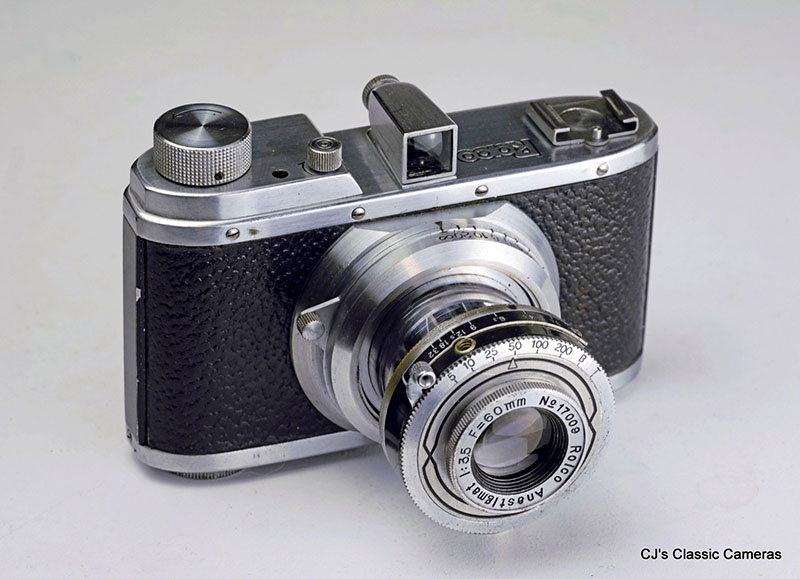
Roico camera with Roico Anastigmat 60mm f/3.5 in unspecified 6-speed leaf shutter. Note the little knob next to the wind knob. This is not a shutter release, and it's not functional on this example and I am not 100% what is was for; it has a little round window next to it so I assume it's a frame counter. Nevertheless, the camera also has a red spy window at the back.
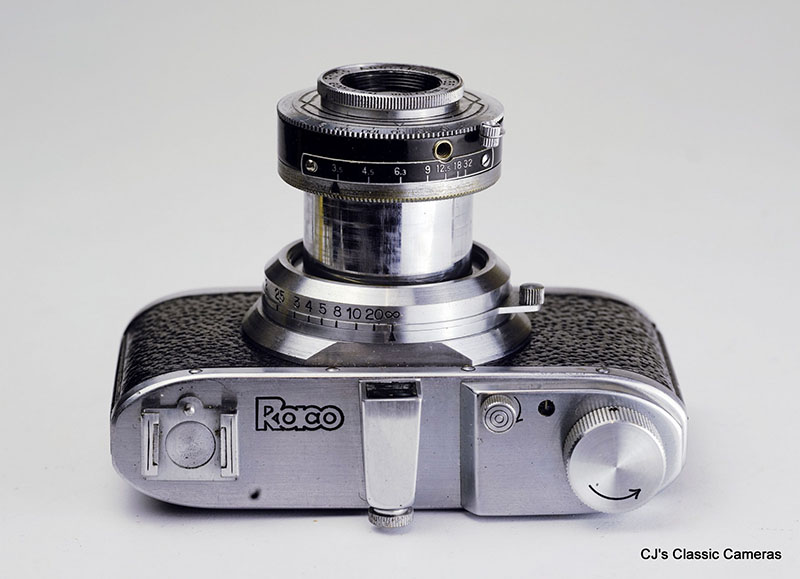
Top view of the Roico with its oull-out lens extended.
Wirgin Gewirette
Just added here for completion, information about this camera can be found on the Wirgin page.
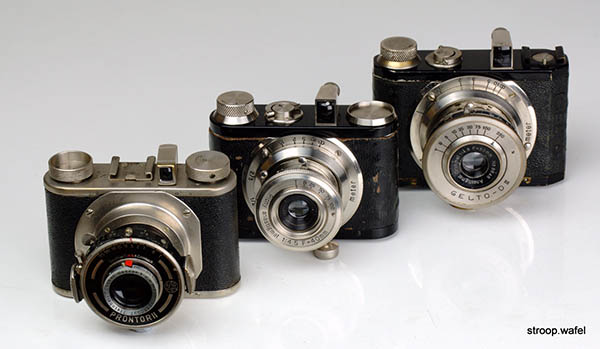
The three musketeers: a Gewirette, Picny and Gelto together. The latter two are thought to be based on the first. They were certainly similar but the Picny and Gelto were finished to a much higher standard.
Foth Derby
The Foth Derby is a somewhat overlooked little folding camera that had impressive specifications for its time, the early 1930s. The history of the Foth Company is quite vague. It appears the company started producing optics and binoculars in the 1920s and was based in Danzig, then part of Germany but nowadays Gdansk in Poland. In the early 1930s the company moved to Berlin and started producing a small line of cameras, including said Derby, as well as a TLR, the Fothflex. Then the history becomes muddled, it appears the company moved to France and merged with Gallus, continuing to produce the Derby and later the Gallus Derlux (see below).
Back to the Derby. The outstanding features of this camera were the focal plane shutter, at the time mainly found on high-end cameras of the likes as Leica and Contax, with a fast top-speed of 1/500s, a helical focus unit and several lenses including a for the time very fast f/2.5 Foth Anastigmat. The frame size was initially 35mm but later increased to 4x3, as commonly found on 127 cameras. This all in a small handy package that would fit in your pocket. The camera was probably fairly popular, as they are still relatively easy to find, and was exported to many countries, including the USA and the UK.
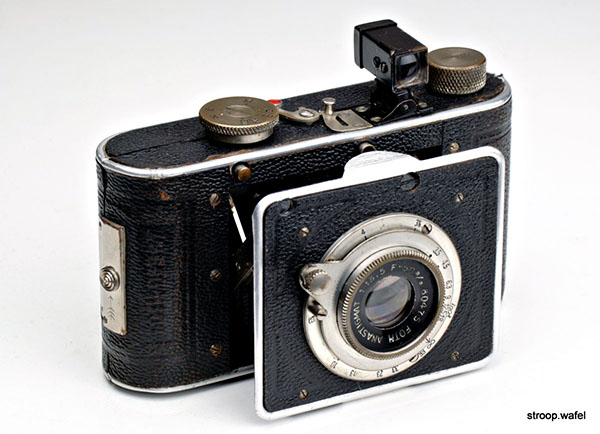
A Foth Derby with Foth Anastigmat 50mm f3/.5 lens.
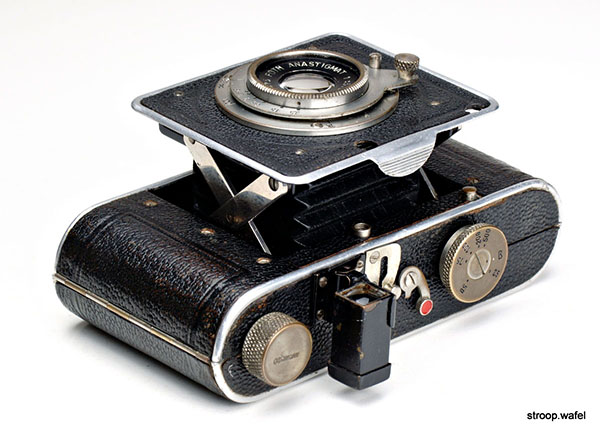
Top view of the Foth Derby showing the scissor-like strut folding mechanism.
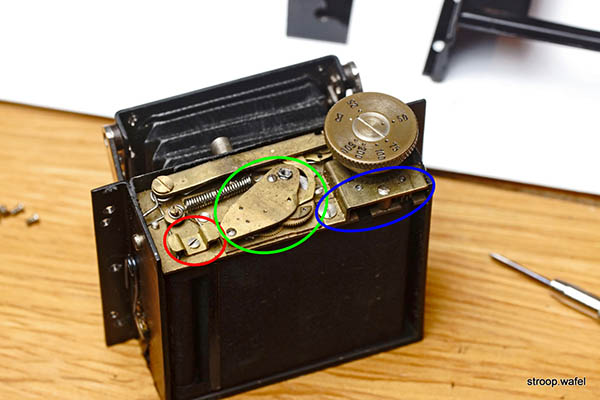
This Derby came with a non-functioning shutter, the ribbons on one of the curtains had gone. The shutter on the Foth Derby is easy to get to and has a simple design, so if you want to get into fixing focal plane shutters, the Derby is a good place to start.
Above oy can see the shutter after being removed from the camera with the folding struts still attached. Beneath the clip marked by the red circle are the tension screws for the curtain rollers. Marked by the blue circle are the supports for the non-tensioned rollers, which are easily removed if curtain repairs are needed. The green circle marks the selftimer mechanism.
Gallus Derlux
The Gallus Derlux was essentially a metal-bodied version of the Foth Derby described above. It was made in France after Foth merged with Gallus, a small camera maker based in Paris. The camera body was made of heavy duty aluminium, but since it's a low density metal, the camera was still light. The controls were pretty much in the same place as the original Derby. And like the Derby, the camera is easy to disassemble into its various components, including the shutter module.
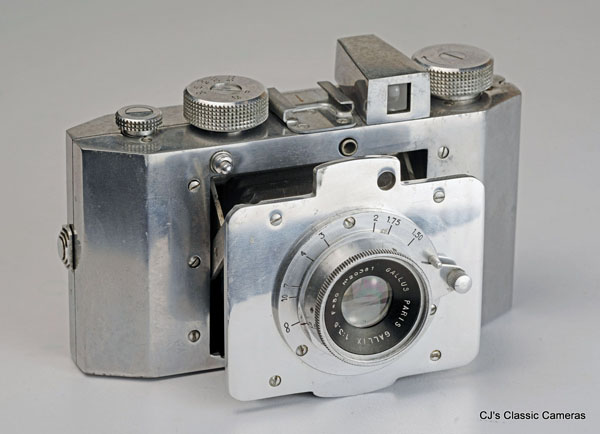
A Gallus Derlux with Gallus Gallix 50mm f3/.5 lens. The hole in the front plate above the lens is for a remote release, which seems a little odd but was in fact inherited from its predecessor, the Foth Derby. The lens looks like it may be removable by unscrewing it, but it's not.
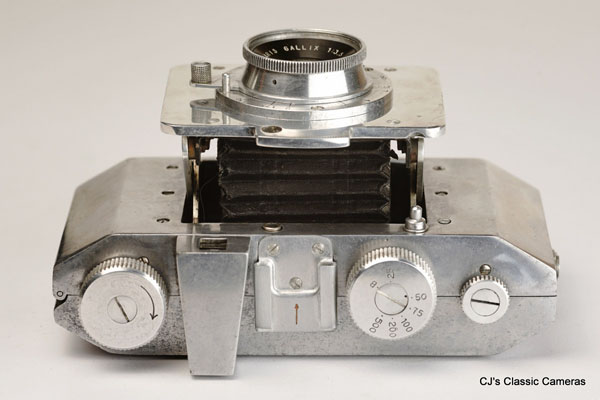
Top view of the Gallus Derlux showing the various knobs and buttons.
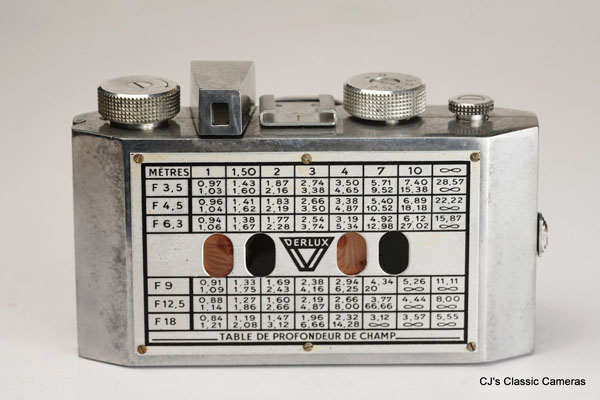
Rear view of the Gallus Derlux showing a detailed depth of field table. The camera had two red spy windows, typical of half frame 127 cameras (with a 3x4 cm film frame), as well as two green ones, of which the purpose escapes me.
Pontiac Lynx II
The Lynx II was made by Pontiac, a French camera maker during the 1930s to 1950s. The Lynx II shows quite a few similarities with the Gallus Derlux above, in having similar materials, format, layout and size. However, it was part of a larger family of Pontiac cameras with included the 35mm Super Lynx and Baby Lynx, which can be found elsewhere on this site. The main difference with the Derlux is that all these cameras had a collapsible lens instead of a pop-out lens board. Like the Derlux, the Lynx II had a focal plane shutter. Interestingly, during the last few years of its existence (early 1950s), Pontiac moved its production to Morocco, so rare examples showing 'Made in Morocco' engraved in the wind knob can be found.
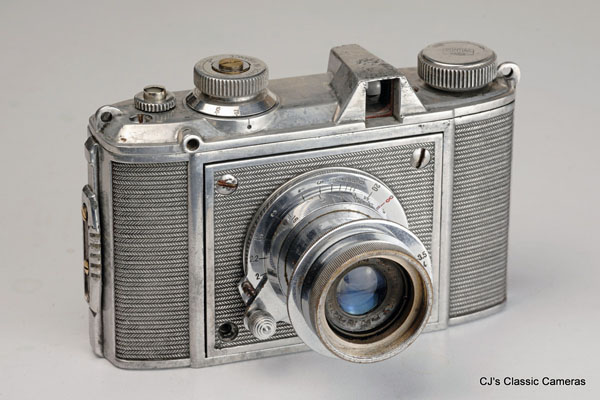
A Pontiac Lynx II with SOM Berthiot Flor 50mm f/3.5 lens. The camera was available with black painted or metal herringbone-style faux cover. This one looks like it was painted black at some point, or perhaps even originally, but it's hard to tell. There's a few screws missing and the speed knob has a non-original screw so it clearly has had a hard life. In fact, the shutter had completely deteriorated and only a single, mostly disintegrated curtain was present.
| 
